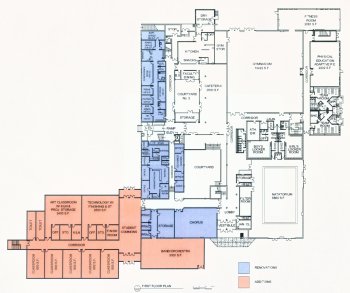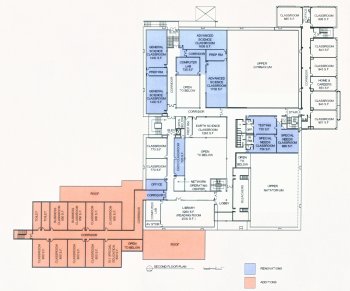- By Dan Veaner
- News
 Print
Print
On February 6th Lansing school district voters will be asked to approve a capital project. Voters will decide whether to approve an $18,725,000 project that includes 51 long term maintenance items in all three schools and the bus garage, renovation and upgrading of three science classrooms/labs, 11 general classrooms including some that offset those lost in renovating science rooms, two business classrooms, a special education room, an art classroom, upgraded main and nurse's offices, and a new district office. At the same time they will be asked to approve a second $2,105,000 proposition to construct a new band/orchestra room and a technology classroom.
If approved, the project won't show up on your tax bill until 2009. And school officials are quick to stress that taxpayers won't pay the entire $20.8 million. State aid will pay for much of the project. Of the $20.1 million around $6.25 million is the part local taxpayers will fund. If both propositions are passed, it will cost 98 cents per thousand of assessed value, and if only the first proposition passes that will be 87 cents per thousand. The high school has dominated the discussion of the project, because it is the building that will get new and renovated space for programs. But a major component of Proposition 1 is a laundry list of needed repairs and upgrades. All three schools need work on their heating/cooling systems. The elementary school needs a new roof and repairs to a leaky gymnasium, new clocks and upgrades to emergency lighting, fire hydrants and rescue window compliant screens.

(Click plan for larger version)
Plans courtesy of King & King Architects, LLP
The middle school will get repairs for voltage fluctuations in the electrical system, upgrades to smoke and fire detectors, window hardware, sump pumps, fire hydrants, upgrades to plumbing fixtures and to toilet rooms to meet requirements, and measures to solve temperature control problems. The auditorium will get a widened exit and a new entrance.
The high school has the longest list of infrastructure repairs and upgrades. It includes repairs to masonry joints and other parts of the building that are deteriorating, window hardware and weather stripping, new ceilings in the pool locker room, locker room showers and entrance renovations, 24 clocks, ventilation controls, a new smoke hatch for the elevator, an upgraded fire alarm system, additional hydrants, additional PA speakers, and new classroom partitions to address noise issues.
Also included are repairs to the leach field behind the school. John Anderson of the Tompkins County Health Department wrote a letter to school Superintendent Mark Lewis on October 3 in which he expressed concern about the sewage systems for all the district buildings. The high school leach field is beneath an athletics field, and Anderson says a small building appears to have been placed on top of the one at the middle school. He also asked Lewis to arrange times when the Health Department could inspect the current sewage systems.
Anderson identified five situations that contribute to State and/or County violations, and strongly urged Lewis to support the Town's proposed sewer project. "Replacing these sewage systems and/or bringing them into compliance will involve great cost and disruption to school grounds," Anderson said. "We encourage the Lansing Central School District to continue working with the Sewer Committee to ensure the district is formed and constructed before any of the systems fail."
The new classrooms and facilities at the high school address program needs on top of the infrastructure concerns the project addresses. Overcrowding is only one of the concerns the new and renovated classrooms address. For example, high school students must walk to the decapitated technology building behind the middle school for some classes, because there is no facility at the high school. High School Principal Michelle Stone argued for a technology room in her building on the grounds that the current facility is in such bad shape that if it were condemned or demolished there would be nowhere for her technology programs. Additionally Stone noted the problems with sending students outside the high school building in all weather with limited time to get from class to class.
Not all of the new classrooms will be new in the sense that they add to the total count. Some of the new classrooms replace space lost by renovating others. For example a couple of science rooms will be enlarged to create a safer separation of laboratory and classroom activities. And a new art room will replace the current unsafe one that will be refitted for special needs classrooms.
While some critics have said that the infrastructure problems should have been addressed incrementally over the years using the district's operating budget, the reality is that they weren't. This means that they must be addressed before they become dangerous to children or cause further damage to district buildings.
So while the high school addition has commanded much of the community's attention, it only accounts for about $4.3 million (about 1/5th) of the $20.8 million project. And because classrooms are such a large component of the addition, it increases the amount of aid the project is eligible for.
----
v3i1
If approved, the project won't show up on your tax bill until 2009. And school officials are quick to stress that taxpayers won't pay the entire $20.8 million. State aid will pay for much of the project. Of the $20.1 million around $6.25 million is the part local taxpayers will fund. If both propositions are passed, it will cost 98 cents per thousand of assessed value, and if only the first proposition passes that will be 87 cents per thousand. The high school has dominated the discussion of the project, because it is the building that will get new and renovated space for programs. But a major component of Proposition 1 is a laundry list of needed repairs and upgrades. All three schools need work on their heating/cooling systems. The elementary school needs a new roof and repairs to a leaky gymnasium, new clocks and upgrades to emergency lighting, fire hydrants and rescue window compliant screens.

(Click plan for larger version)
Plans courtesy of King & King Architects, LLP
The middle school will get repairs for voltage fluctuations in the electrical system, upgrades to smoke and fire detectors, window hardware, sump pumps, fire hydrants, upgrades to plumbing fixtures and to toilet rooms to meet requirements, and measures to solve temperature control problems. The auditorium will get a widened exit and a new entrance.
The high school has the longest list of infrastructure repairs and upgrades. It includes repairs to masonry joints and other parts of the building that are deteriorating, window hardware and weather stripping, new ceilings in the pool locker room, locker room showers and entrance renovations, 24 clocks, ventilation controls, a new smoke hatch for the elevator, an upgraded fire alarm system, additional hydrants, additional PA speakers, and new classroom partitions to address noise issues.
Also included are repairs to the leach field behind the school. John Anderson of the Tompkins County Health Department wrote a letter to school Superintendent Mark Lewis on October 3 in which he expressed concern about the sewage systems for all the district buildings. The high school leach field is beneath an athletics field, and Anderson says a small building appears to have been placed on top of the one at the middle school. He also asked Lewis to arrange times when the Health Department could inspect the current sewage systems.
Anderson identified five situations that contribute to State and/or County violations, and strongly urged Lewis to support the Town's proposed sewer project. "Replacing these sewage systems and/or bringing them into compliance will involve great cost and disruption to school grounds," Anderson said. "We encourage the Lansing Central School District to continue working with the Sewer Committee to ensure the district is formed and constructed before any of the systems fail."
The new classrooms and facilities at the high school address program needs on top of the infrastructure concerns the project addresses. Overcrowding is only one of the concerns the new and renovated classrooms address. For example, high school students must walk to the decapitated technology building behind the middle school for some classes, because there is no facility at the high school. High School Principal Michelle Stone argued for a technology room in her building on the grounds that the current facility is in such bad shape that if it were condemned or demolished there would be nowhere for her technology programs. Additionally Stone noted the problems with sending students outside the high school building in all weather with limited time to get from class to class.
Not all of the new classrooms will be new in the sense that they add to the total count. Some of the new classrooms replace space lost by renovating others. For example a couple of science rooms will be enlarged to create a safer separation of laboratory and classroom activities. And a new art room will replace the current unsafe one that will be refitted for special needs classrooms.
While some critics have said that the infrastructure problems should have been addressed incrementally over the years using the district's operating budget, the reality is that they weren't. This means that they must be addressed before they become dangerous to children or cause further damage to district buildings.
So while the high school addition has commanded much of the community's attention, it only accounts for about $4.3 million (about 1/5th) of the $20.8 million project. And because classrooms are such a large component of the addition, it increases the amount of aid the project is eligible for.
----
v3i1




